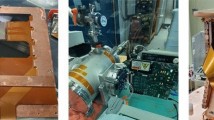Abstract
Six small gold disks, 15 mm. in diameter and 0.5 mm. thick, were placed in a hole in a cadmium plate and irradiated by slow neutrons, by putting the whole arrangement in a cavity in a large block of paraffin wax, near a radon-beryllium source. On measuring the activities of the successive disks, it was discovered that the bottom of the lowest disk (which lay directly on the cadmium) was very much more active than the top of the same disk, and was indeed comparable in activity with the uppermost disk. All the disks decayed with the normal gold period (2½ days).
Similar content being viewed by others
References
La Ricerca Scientifica, Anno VI, 2, 9–10.
NATURE, 136, 950 (1935).
Author information
Authors and Affiliations
Rights and permissions
About this article
Cite this article
FRISCH, O., HEVESY, G. & MCKAY, H. Selective Absorption of Neutrons by Gold. Nature 137, 149–150 (1936). https://doi.org/10.1038/137149b0
Issue Date:
DOI: https://doi.org/10.1038/137149b0
- Springer Nature Limited
This article is cited by
-
Capture of Slow Neutrons
Nature (1936)
-
The Form of Nuclear Levels
Nature (1936)
-
Neutroneneinfang und Bau der Atomkerne
Die Naturwissenschaften (1936)





